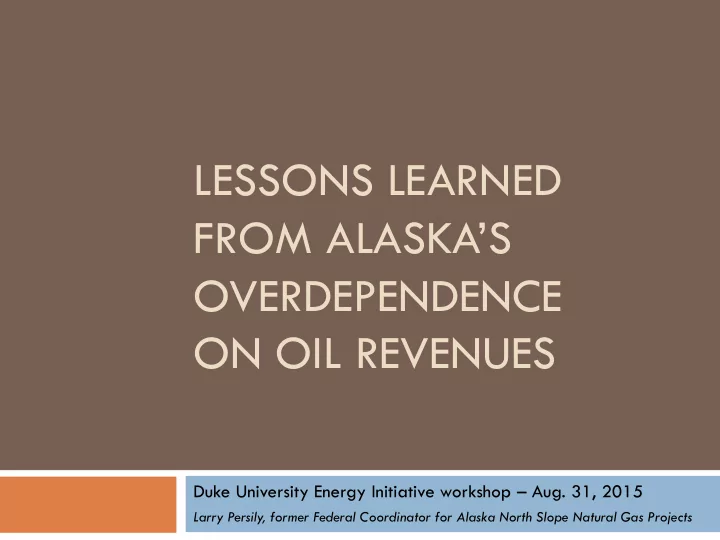

LESSONS LEARNED FROM ALASKA’S OVERDEPENDENCE ON OIL REVENUES Duke University Energy Initiative workshop – Aug. 31, 2015 Larry Persily, former Federal Coordinator for Alaska North Slope Natural Gas Projects
Reliance on oil started early 2 Statehood 1959; Prudhoe Bay discovery 1968 But pipeline delays lead to state cash-flow squeeze Oil companies prepaid taxes in 1975 to help out Oil pipeline started in 1977, and the money flowed Voters created Permanent Fund 1976 to save some Legislature in 1980 abolished personal income tax and also eliminated the business gross receipts tax
Spending grew to match revenues 3 Between 1965 and 1985, population doubled as state spending per capita increased eight-fold State budget $6 billion FY16 for 735,000 residents The good years saw $1-billion-plus capital budgets Mistakes along the way: Hundreds of millions lost on grain terminal, seafood plant, petrochemical plant, massive hydro dam, barley farming project Oil and gas pays for one-third of jobs in Alaska
4
Share-the-wealth program 5 State saves 25% of its oil and gas royalties Permanent Fund invests in stocks, bonds, real estate About half the earnings are paid to Alaskans Annual checks have totaled $22 billion since 1982 Almost $39,000 if you received every dividend Legislature approved a $1,200 bonus in 2008 Dividends have become essential part of economy
Alaska’s overdependence 6 Oil and gas revenues provide 90% of state dollars Next largest: smokers, drinkers, insurance premiums Motor fuel taxes lowest in nation; same 8¢ as 1961 No state sales tax or personal income tax Oil-wealth Permanent Fund only used for dividends Declining oil production, low prices = budget crisis Local governments hit hardest by state budget cuts
Oil tax battles divide state 7 North Slope oil production one-quarter of peak Best the state can hope for is to stem the decline Meanwhile , the state is ‘spending’ $1 billion a year in tax credits to encourage oil and gas exploration State cut oil taxes 2013; initiative failed to overturn Oil tax political battles are monumental in Alaska Many Alaskans feel cheated on oil tax revenues because although we got rich — Big Oil got richer
Panic in the Far North 8 A $3-billion-plus gap in $6 billion state budget Reserves amassed during oil-price spike are filling that gap, but state could drain reserves in two years Legally, morally impossible to cut state budget 50% Businesses worry spending cuts could harm economy Local governments fear for their own budgets After two generations of tax-free living, Alaskans talking taxes and using Permanent Fund earnings
S&P tells the truth 9 Ratings agency lowers state to negative outlook S&P’s stern warning: “The magnitude of the fiscal deficits makes the arrangement unsustainable.” “By introducing a statewide income or sales tax … the state could generate several hundred million in unrestricted revenue annually. … In our view, therefore, the state has sufficient potential fiscal resources — if it can assemble the political will — to restore alignment in its … main operating fund .”
Costly fiscal lessons 10 If it’s free, no one asks how much it costs No one wins their election telling the public no Abolishing personal taxes removes any link between the public’s appetite and fiscal restraint Municipalities, nonprofits over-reliant on state Beware the ‘Alaska Disconnect’ — without taxes to benefit from increased economic activity, more jobs and more residents are a financial burden on state
Recommend
More recommend